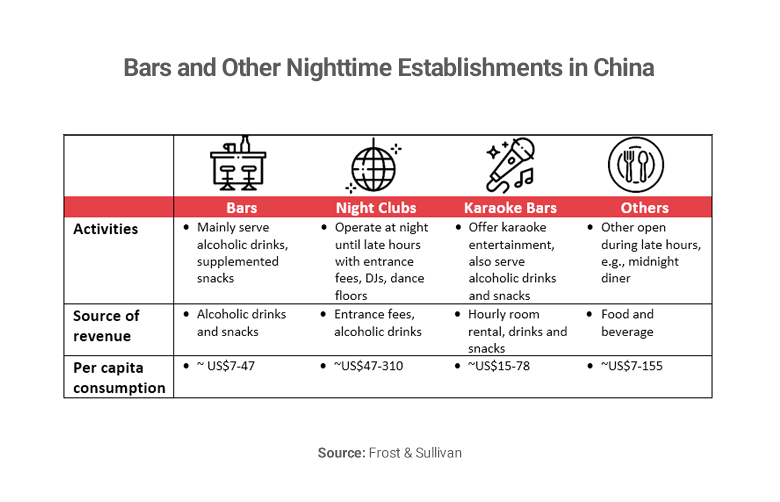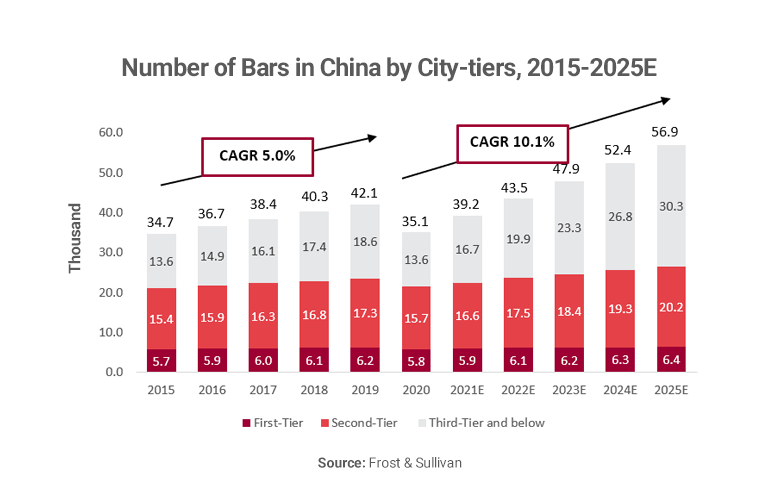
China’s largest pub chain operator, Helens International Holding, went public in September 2021, making its Chairman the newest billionaire of China. Despite the influence of the COVID-19 pandemic, the bar industry in China is forecasted to have extremely high growth, providing various market opportunities for new entrants.
China’s Newest Billionaire
Helens International Holding, the operator of China’s largest bar chain, debuted on the Hong Kong Stock Exchange on September 10, 2021. On the momentous day, Helens’ shares surged by 22.9% from its IPO price, raving a market capitalization of US$3.9 billion and making its creator the newest billionaire of China’s growing bar industry.
Helens International Holding engages in bar operations and franchise business in China, providing customers with a product portfolio of mainly self-branded products and offline social spaces. The Chairman and CEO, Xu Bingzhong, opened his first “Helen’s bar” in 2009. As of 2021, there have been respectively 66, 296, and 165 Helen’s bars in first-tier, second-tier, and third-tier cities in China, and Helens has been the market leader by number of bars in China since 2018, In 2020, the group was ranked first in China’s bar industry, with a market share of 1.1%. Its revenue that year was US$127.1 million. In the first quarter of 2021 (January-March), Helens’ revenue increased with a year-on-year growth of 494.5%, from 62 million to 368.6 million yuan.
China’s Growing Bar Industry
Bars are categorized under China’s catering market. Primarily serving alcohol and supplemental snacks, bars are also grouped within the nighttime industry. Several bars also have other facilities as part of their establishments, including karaoke, billiards, and arcade games.
China’s bar industry heavily benefited from the rise in disposable income of Chinese residents. By 2019, its revenue reached US$18.9 billion, equivalent to a CAGR of 8.7% from 2015. After COVID-19 heavily limited social gatherings, China’s bar industry faced a drop in revenue in 2020. However, the industry is expected to fully recover by 2022 with a forecasted revenue of US$21 billion, much higher than its pre-pandemic level.
Revenue generated by the bar industry is also forecasted to reach US$29.4 billion by 2025, representing an impressive CAGR of 18.8%. Economic growth alongside disposable income allows the catering industry in general, and the nighttime industry specifically, to flourish. The rate of urbanization birthing new second and third-tier cities also creates opportunities for new bar ownership. Cities in third-tier cities and below had a CAGR of 13.8% from 2015-2019, which is much higher than that of the second (8.1%) and first-tier (6.3%) cities.
By the end of 2019, China had approximately 42,000 bars, a CAGR of 5% comparing to 35,000 bars at the end of 2015. The number of bars dropped in 2020 due to small and independent bars being unable to generate cash flows during the pandemic. Nevertheless, the number of bars in China is expected to recover gradually in 2021 and 2022, as social restrictions are relaxed.

The country’s third-tier cities and below has a massive untapped consumer base, boasting a population of 1.1 billion, approximately 78% of China’s total population. The growth in the number of bars in those cities is forecasted to be at 17.4% in the next five years, surpassing the number of bars in second-tier cities.
China’s bar industry is highly fragmented, consisting mainly of independent bars and bars with less than three establishments, and only a few bar chain networks. Over 95% of the total 35,000 bars in China in 2020 were independent bars. The top five bar operators in China have a total market share of approximately 2.2% in 2020 in terms of revenue (half of which is of Helens), leaving a large potential for further concentration in the market. Strong bar operators with highly standardized services, mature supply chains, and sufficient capital support would enjoy a strong competitive advantage. A clear example is Helens, who despite halting business, still managed to generate a net profit of $11 million during 2020.
A Young and Growing Population Ensures Strong Growth in Upcoming Years
The development of the nighttime industry has enabled strong growth in the bar industry. Apart from the mentioned drivers of high economic growth and governmental support, China also has a large population of young consumers. By 2020, the number of young people aged 20-34 in China reached nearly 300 million, equivalent to 21.2% of the total population. Young Chinese people are considered socially active, brand-sensitive, and more inclined to affordable goods and high-quality services. Thus, this group increases the demand for entertainment and social gatherings.
The rate of urbanization in third-tier cities and below also create a large consumer group to tap into. The large consumer base, coupled with increasing income, is expected to drive the growth in bar spending by the residents of these cities.
Market Trends and Opportunities
In recent years, China’s catering industry has seen an increasing presence of private-label alcohol drinks, which are usually self-developed under the same name brand as their establishments. The self-owned brands help build the bars’ unique culture and brand images.
Furthermore, evolving technologies in the industry are transforming the traditional consumption experience in the bar industry. Automated service and the development of new products are changing the way bars operate. This provides new opportunities as investments in technologies would allow bar operators to enhance consumers’ experience, while also streamlining operations to reduce costs and achieve economies of scale.
In conclusion, Helens International Holding’s successful IPO shows the great potential of China’s bar industry, even amid a raging pandemic. The industry is set for robust growth in the future, backed by an increase in consumer spending power and demands in third-tier cities and below. There are also emerging trends in the market with the development of chained bar brands, a greater focus on brand recognition, and the introduction of private-label alcoholic drinks.
Read more about our consumer product expertise or our consulting services.
The insights provided in this article are for general informational purposes only and do not constitute financial advice. We do not warrant the reliability, suitability, or correctness of the content. Readers are advised to conduct independent research and consult with a qualified financial advisor before making any investment decisions. Investing in financial markets carries risks, including the risk of loss of principal. Past performance does not guarantee future results.
The views expressed herein are those of the author(s) and do not necessarily reflect the company's official policy. We disclaim any liability for any loss or damage arising from the use of or reliance on this article or its content. ARC Group relies on reliable sources, data, and individuals for its analysis, but accuracy cannot be guaranteed. Forward-looking information is based on subjective judgments about the future and should be used cautiously. We cannot guarantee the fulfillment of forecasts and forward-looking estimates. Any investment decisions based on our information should be independently made by the investor.
Readers are encouraged to assess their financial situation, risk tolerance, and investment objectives before making any financial decisions, seeking professional advice as needed.



